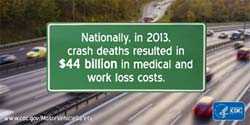Holiday Road Safety
 Stay safe on the roads and take action to protect yourself and your loved ones.
Stay safe on the roads and take action to protect yourself and your loved ones.
In the United States, motor vehicle crashes are in the top 10 causes of death for people aged 1-54, and more than 30,000 people are killed in crashes each year. However, many of these deaths can be prevented. Buckle up, drive sober, and stay safe on the roads this holiday season.
Child Passenger Safety
Motor vehicle injuries are a leading cause of death among children, but you can make a difference.
- Buckle children in age- and size-appropriate car seats, booster seats, and seat belts—these reduce serious and fatal injuries in a car crash by more than half.
- Remember that children aged 12 and under should be properly buckled in the back seat.
- Set a good example by always wearing a seat belt yourself.
- Learn more about child passenger safety.

Protect yourself and your little ones during heavy traffic season.

Use a seat belt in every seat, on every trip, no matter how short.
Teen Driver Safety
If you have a teenage driver in your family, take advantage of our resources that spell out concrete ways to help your teen stay safe on the road.
- Know your state’s laws; all states have graduated driver licensing (GDL) systems which help ensure teens can build driving skills under low-risk conditions.
- Consider using tools like parent-teen driving agreements.
- Get in some supervised driving time with your teen over the holidays.
Everyone’s Safety
Motor vehicle safety applies to everyone. Here are some tips to help keep you safe over the holidays.
- Use seat belts on every trip, no matter how short.
- Make sure passengers buckle up, too. Unbuckled passengers can injure other passengers in a crash.
- Alcohol, even in small amounts, can impair driving. Don’t drive after drinking alcohol or using drugs, and help others do the same.
More Information
More Information
Learn more about all of these tips and more at Injury Prevention & Control: Motor Vehicle Safety
- Page last reviewed: December 21, 2016
- Page last updated: December 21, 2016
- Content source:
- National Center for Injury Prevention and Control, Division of Unintentional Injury
- Page maintained by: Office of the Associate Director for Communication, Digital Media Branch, Division of Public Affairs




 ShareCompartir
ShareCompartir